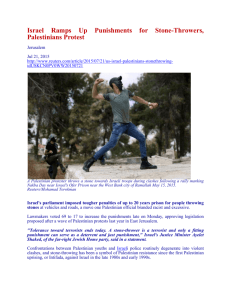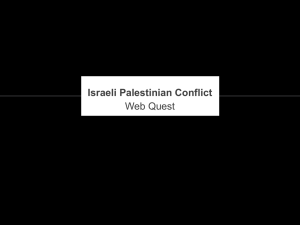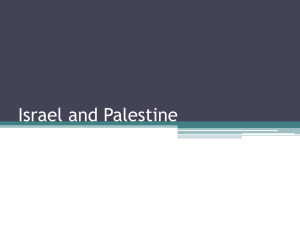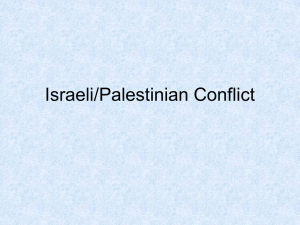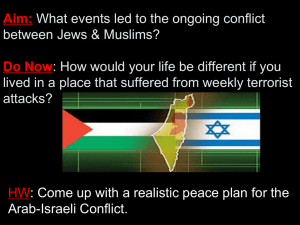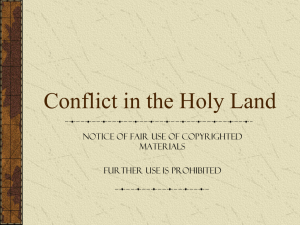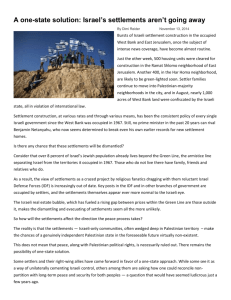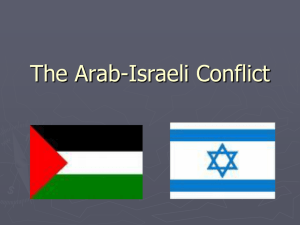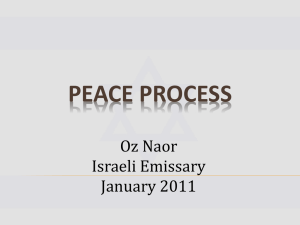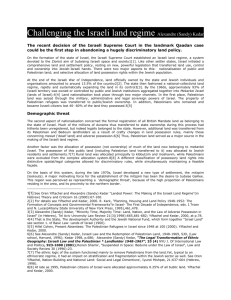Israel Conference Pre
advertisement
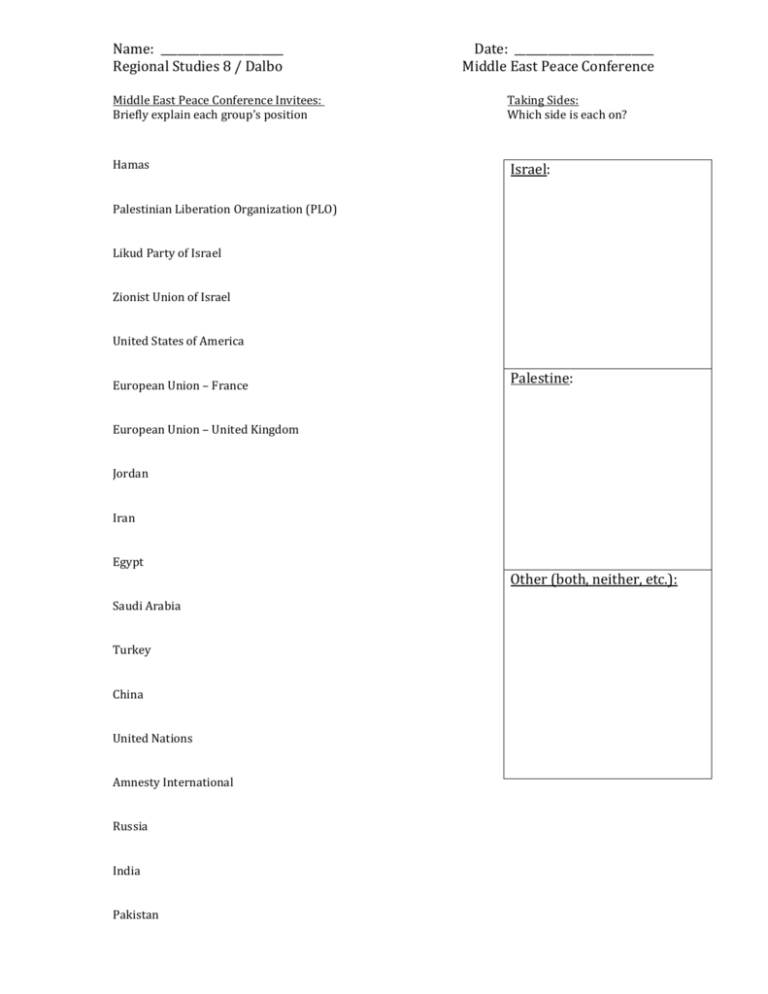
Name: ______________________ Regional Studies 8 / Dalbo Date: _________________________ Middle East Peace Conference Middle East Peace Conference Invitees: Briefly explain each group’s position Taking Sides: Which side is each on? Hamas Israel: Palestinian Liberation Organization (PLO) Likud Party of Israel Zionist Union of Israel United States of America European Union – France Palestine: European Union – United Kingdom Jordan Iran Egypt Other (both, neither, etc.): Saudi Arabia Turkey China United Nations Amnesty International Russia India Pakistan Key Issues Territory - Gaza is a small enclave that abuts the Mediterranean Ocean and Egypt to the southwest. It is one of the most densely populated areas in the world, with close to 1 million people. Poverty and unemployment are rampant. The Islamic Palestinian party, Hamas, is very strong in Gaza. There are only a few Jewish settlements in Gaza and they are guarded by thousands of Israeli soldiers. The West Bank is situated west of the Jordan River and Dead Sea, and east of most of Israel. Israel has occupied the land since its victory in 1967. It is now home to 2.1 million people, over 200,000 of whom are Jewish settlers. Of the 1.9 million Palestinians, over 500,000 are refugees, many still living in refugee camps. The economy is largely agricultural. Until the past two years, both Palestinian and Jewish residents who live in the West Bank crossed the border into Israel each day to work. Now only Jews can do so. Israel’s population is about 6.6 million. 5.3 million are Jews and 1.3 million are Arabs and others (such as Druze). If Israel were to absorb the territories it currently occupies, its population would be about 9.7 million, with 4.2 million non-Jews. Security - Israel says that it cannot accept Palestinian authority over the occupied territories if the security of Israeli citizens is not guaranteed. Thus, the Israeli government continues to hold Yasser Arafat and the Palestinian Authority responsible for the attacks on civilians in Israel. In addition, even if the borders of Israel were more secure, Israel does not trust the Palestinians to ensure the security of Jewish settlements. On the other hand, Palestinians do not believe that Israel will ever allow true self-determination. Even as Israel withdrew troops from some major cities in the West Bank, soldiers continued to protect Jewish settlements. In fact, most Palestinians claim that there was never any Israeli withdrawal from the occupied territories, merely redeployment. For the past two years, to ensure security, the occupied territories have been under a near total “lock-down.” Palestinians, who depend on work in Israel, cannot travel there any more. Often, Palestinians cannot travel from town to town. Israeli military checkpoints are omnipresent. Military curfews are often imposed and schools shut down frequently. The economic consequences for Palestinians have been devastating. The average income of a Palestinian in the occupied territories is now 10% of that of an Israeli. More Israeli citizens have been killed by terrorist attacks under Prime Minister Sharon’s term than under any other period of an Israeli prime minister. And, the retaliation for such attacks has usually been very strong, including the use of tanks and airpower in the West Bank and Gaza. While some of the major figures in radical Palestinian groups have been killed or captured, most of the victims have been Palestinian civilians. Israel continues to demand that the Palestinian Authority be responsible for preventing terrorist attacks, yet the Israeli military has destroyed most of the infrastructure and capacity for Palestinians to act as a functioning government authority. Settlements - The first settlements in the occupied territories sprang up shortly after the 1967 war, and were intended essentially as security outposts. A few religious groups set up Jewish settlements to stake a claim to what they thought were ancient biblical lands. By 1980, there were 12,000 settlers, most of whom were religious Jews who saw the land of the West Bank as the sacred biblical lands of Judea and Samaria. These settlers were encouraged to settle in the Palestinian territories by the Likud government in the late 1970s. In the 1980s, economic incentives were utilized by the government to entice new settlers to the land and the government itself was building many of the new Jewish communities in the West Bank. The number of settlers by 1990 was 76,000 and by 1995 was 146,000. Today, the figure is close to 210,000 settlers, almost all of whom are in the West Bank. Most of the settlements close to Jerusalem and Tel Aviv house Israelis who moved there because the housing was cheaper and the commutes to jobs easier. Many of those who live in more remote settlements strongly believe that Israel has a right to this land and have worked very hard to undermine any peace agreement that would cede territory to Palestinians. Refugees and the right of return - Nearly three million Palestinians are refugees. Half a million live in the West Bank; the rest are mostly in refugee camps in Lebanon and Jordan or are spread elsewhere in the Middle East and the west as part of a large Palestinian Diaspora. Most of the refugees either lost their homes in 1948 or are the descendants of those who lived within the borders of the state of Israel. Some became refugees after the occupation of the West Bank and Gaza in 1967. Jerusalem - In the original UN partition plan, Jerusalem was to remain under international authority because of its prime status for the religions of Judaism, Islam and Christianity. In 1948 the state of Israel controlled the western part of Jerusalem while Jordan controlled the eastern part, including the old city, home to the most important holy sites of the three religions. Israel wants to maintain sovereignty and control over all of Jerusalem while the Palestinians want sovereignty over East Jerusalem and to establish it as the capital of a Palestinian state. East Jerusalem is majority Arab but new Jewish settlements have been built to help solidify the Israeli claim to the whole city. Incitement - Hateful language, propaganda, and images emanating from school books, the media, and from religious authorities on both sides have led to violence that has rapidly increased in the past two years. True peace and reconciliation are impossible in such an environment. A major part of the problem is that when the Oslo peace process was underway, many people in both communities saw little benefit from peace. From 1992-2000, the standard of living for the average Palestinian declined in half while Israelis saw a rise in violence during that same period. Directions: Fill in the following chart using the above statements (keywords are okay). What might the Israeli and Palestinian views be for each issue? You might have extrapolate (infer) based on each statement. Issue: Territory Security Settlements Refugees Jerusalem Incitement Israeli View: Palestinian View:
